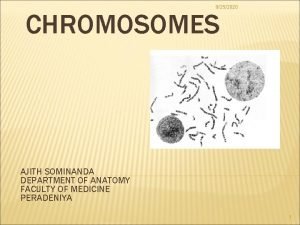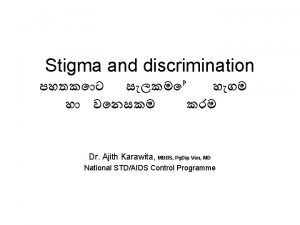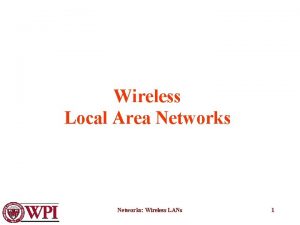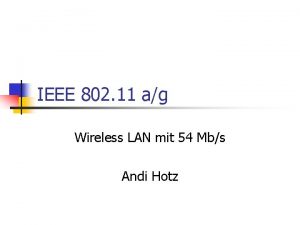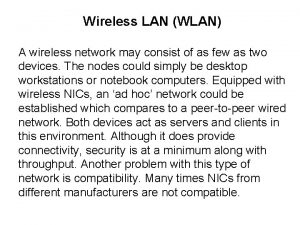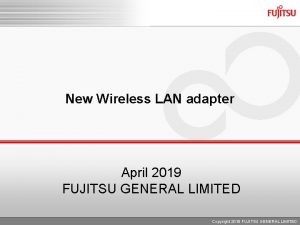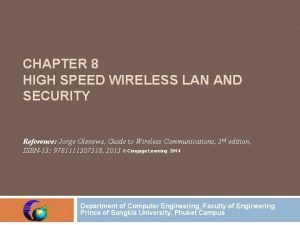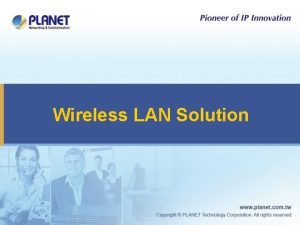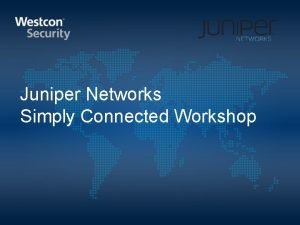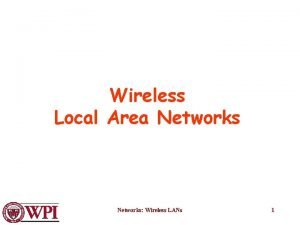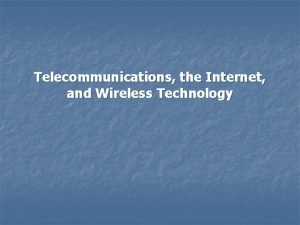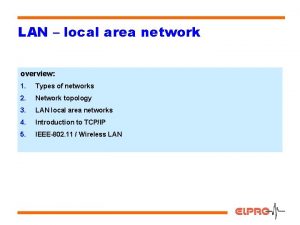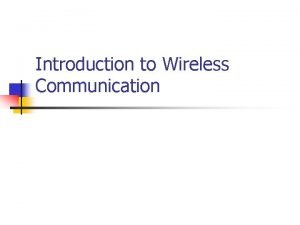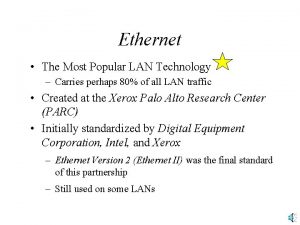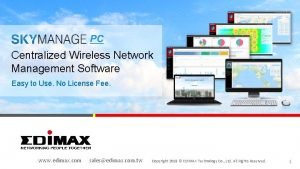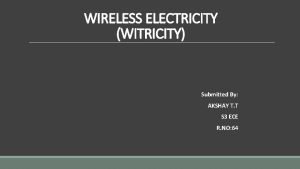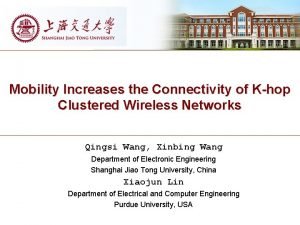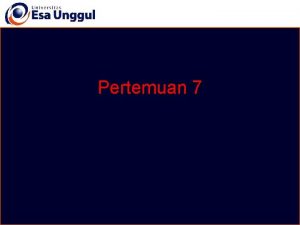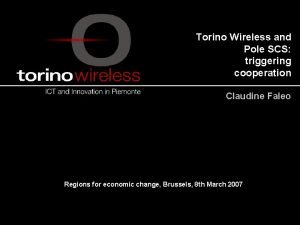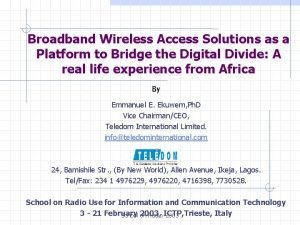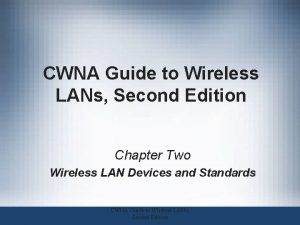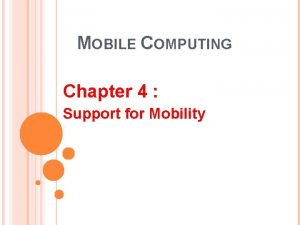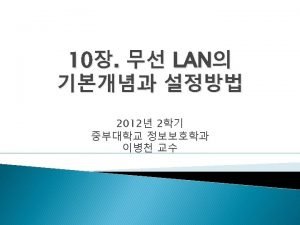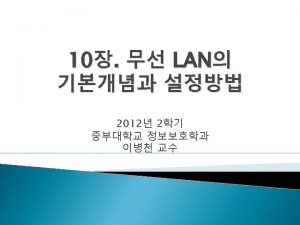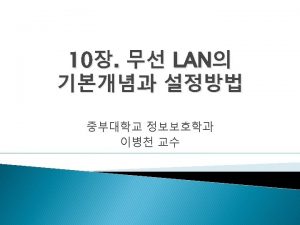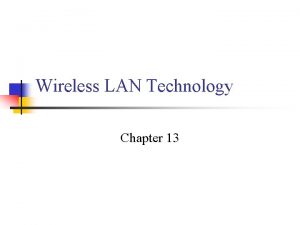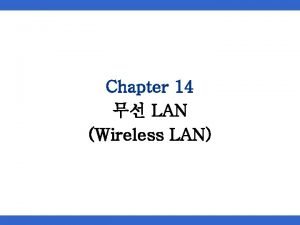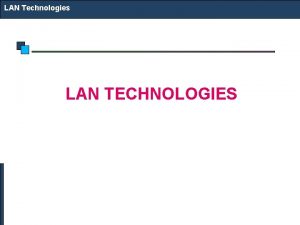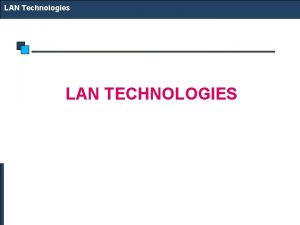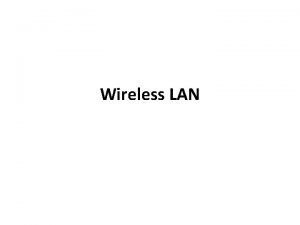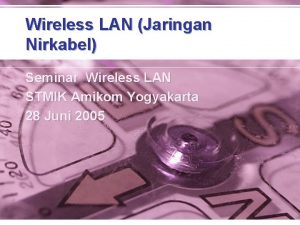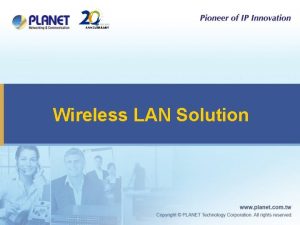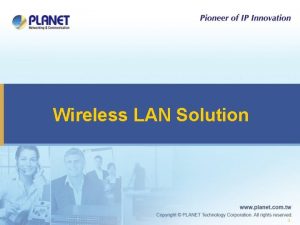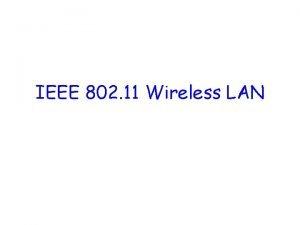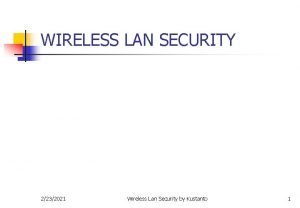Wireless LAN Technology Wireless LAN Ajith G S































- Slides: 31

Wireless LAN Technology Wireless LAN Ajith G. S: poposir. orgfree. com

Wireless LAN Technology • It is LAN technology that makes use of wireless transmission • Emerged in 1980 s • Makes networking simple • It satisfy the requirements for mobility, relocation and ad hoc networking and coverage of locations difficult to wire. • Saves the cost of the installation of LAN cabling • Allows resource sharing without additional wiring Ajith G. S: poposir. orgfree. com

Wireless LAN Technology Ajith G. S: poposir. orgfree. com

Wireless LAN Applications • • LAN Extension: Cross-building interconnect Nomadic Access Ad hoc networking Ajith G. S: poposir. orgfree. com

LAN Extension • In the late 1980 s, were marketed as substitutes for traditional wired LANs • It was not used widely because of the existing prewiring and reliance on twisted pair cabling. • But in a number of environments, there is a role for the wireless LAN as an alternative to a wired LAN. • buildings with large open areas • historical buildings • Small offices where installation and maintenance of wired LANs is not economical. • Wireless LAN linked into a wired LAN on same premises Ajith G. S: poposir. orgfree. com

LAN Extension • Backbone wired LAN such as Ethernet that supports servers a stationary workstations and one or more bridges or routers • Control Module(CM) acts as an interface to the wireless LAN • CM contains some sort of access control logic and includes either bridge or router functionality to link the wireless LAN to the backbone. Ajith G. S: poposir. orgfree. com

LAN Extension • Figure: A single cell Wireless LAN Ajith G. S: poposir. orgfree. com

LAN Extension • Figure: A Multiple cell Wireless LAN Ajith G. S: poposir. orgfree. com

Cross-Building Interconnect • Connect LANs in nearby buildings(wired or wireless) • Point-to-point wireless link is used • Devices connected are typically bridges or routers Ajith G. S: poposir. orgfree. com

LAN Extension Nomadic Access • The provider's fixed antennas communicate with an antenna on the user's device. eg: Wi. Fi • Link between LAN hub and mobile data terminal • Also useful in extended environment such as campus or cluster of buildings • Users move around with portable computers • May wish access to servers on wired LAN Ajith G. S: poposir. orgfree. com

LAN Extension Nomadic Access Ajith G. S: poposir. orgfree. com

Ad Hoc Networking Temporary peer-to-peer network set up to meet immediate need Network for duration of meeting Example: Group of employees with laptops convene for a meeting; employees link computers in a temporary network for duration of meeting • Military applications • Disaster scenarios • • Ajith G. S: poposir. orgfree. com

Wireless LAN Requirements Same as any LAN High capacity, short distances, full connectivity, broadcast capability Throughput: MAC protocols efficient use of wireless medium Number of nodes: Hundreds of nodes across multiple cells Connection to backbone LAN: Use control modules to connect to both types of LANs • Service area: 100 to 300 m • Long power consumption: Need long battery life on mobile stations • Must not require nodes to monitor access points or frequent handshakes • • • Ajith G. S: poposir. orgfree. com

Wireless LAN Requirements • Transmission robustness and security: Interference prone and easily eavesdropped • Collocated network operation: Two or more wireless LANs in same area • License-free operation • Handoff/roaming: Move from one cell to another • Dynamic configuration: Addition, deletion, and relocation of end systems without disruption to users Ajith G. S: poposir. orgfree. com

Wireless LAN Categories • According to the transmission medium used, wireless LAN are categorized into: • Infrared (IR) LANs: Individual cell of IR LAN limited to single room • IR light does not penetrate opaque walls • Spread spectrum LANs: Mostly operate in ISM (industrial, scientific, and medical) bands • No Federal Communications Commission (FCC) licensing is required • Narrowband microwave: Microwave frequencies but not use spread spectrum • Some require FCC licensing Ajith G. S: poposir. orgfree. com

Wireless LAN Categories Infrared (IR) LANs • Infrared communication is very common Used in variety of remote control devices • An individual cell is limited to a single room because infrared light does not penetrate walls. • Infrared networking uses electromagnetic radiation with wavelengths of 820 to 890 nanometres. Ajith G. S: poposir. orgfree. com

Wireless LAN Categories • • • Infrared (IR) LANs Strengths of Infrared Spectrum for infrared virtually unlimited Possibility of extremely high data rates Infrared spectrum unregulated Shares some properties of visible light Equipment inexpensive and simple Uses intensity modulation IR receivers need to detect amplitude of optical signals Reflected by light-colored objects Ceiling reflection for entire room coverage Does not penetrate walls More easily secured against eavesdropping Less interference between different rooms Ajith G. S: poposir. orgfree. com

Wireless LAN Categories • • • Infrared (IR) LANs Drawback Indoor environments experience infrared background radiation Sunlight and indoor lighting makes noise in an infrared receiver Transmitters of higher power required Limited by concerns of eye safety and excessive power consumption Limits the range Ajith G. S: poposir. orgfree. com

Wireless LAN Categories • • Infrared (IR) LANs IR Data Transmission Techniques Directed Beam Infrared Omni-directional Configuration Diffused Ajith G. S: poposir. orgfree. com

Wireless LAN Categories Infrared (IR) LANs Directed Beam Infrared • The infrared light is focused before transmitting the signal. This method increases the transmission speed. • Transmitted signal can be pointed and aimed • Used to create point-to-point links • Range depends on emitted power and degree of focusing • Used to set up a ring LAN. • Focused IR data link can have range of kilometers • Cross-building interconnect between bridges or routers Ajith G. S: poposir. orgfree. com

Wireless LAN Categories Infrared (IR) LANs Directed Beam Infrared • Token Ring LAN using Point-to-Point IR link Ajith G. S: poposir. orgfree. com

Wireless LAN Categories Infrared (IR) LANs Omni-directional Configuration • • • Single base station within line of sight of all other stations on LAN Station typically mounted on ceiling Base station acts as a multiport repeater Ceiling transmitter broadcasts signal received by IR transceivers transmit with directional beam aimed at ceiling base unit Ajith G. S: poposir. orgfree. com

Wireless LAN Categories Infrared (IR) LANs Diffused • The infrared light transmitted by the sender unit fills the area (e. g. office). Therefore the receiver unit located anywhere in that area can receive the signal. • All IR transmitters focused and aimed at a point on diffusely reflecting ceiling • IR radiation strikes ceiling • Reradiated omni-directionally • Picked up by all receivers Ajith G. S: poposir. orgfree. com

Wireless LAN Categories Spread spectrum LANs • Multiple-cell arrangement • Adjacent cells make use of different center frequencies within the same band to avoid interference. • Within a cell, either peer-to-peer or hub • Peer-to-peer topology • No hub • Access controlled with MAC algorithm • CSMA • Appropriate for ad hoc LANs Ajith G. S: poposir. orgfree. com

Wireless LAN Categories Spread spectrum LANs • Hub topology • The hub is mounted on the ceiling and connected to a backbone wired LAN as well as the stations in the wireless LAN • The hub controls the access • The station may broadcast using omnidirectional antenna • The hub is responsible for the automatic hand off of stations. Ajith G. S: poposir. orgfree. com

Wireless LAN Categories Spread spectrum LANs • • Methods Two methods are used: Direct Sequence Spread Spectrum(DSSS) Frequency Hopping Spread Spectrum(FHSS) Ajith G. S: poposir. orgfree. com

Wireless LAN Categories Spread spectrum LANs • • Transmission Issues Licensing regulations differ from one country to another USA FCC authorized two unlicensed applications within the ISM band: Spread spectrum - up to 1 watt Very low power systems- up to 0. 5 watts 902 - 928 MHz (915 -MHz band)-Industrial 2. 4 - 2. 4835 GHz (2. 4 -GHz band)-Scientific 5. 725 - 5. 825 GHz (5. 8 -GHz band)-Medical Ajith G. S: poposir. orgfree. com

Wireless LAN Categories Spread spectrum LANs • Bandwidth • Higher frequency means higher potential bandwidth • Large number of devices works around 900 MHz, including cordless telephones, wireless microphones, and amateur radio • Fewer devices at 2. 4 GHz; • Little competition at 5. 8 GHz • Higher frequency band, more expensive equipment Ajith G. S: poposir. orgfree. com

Wireless LAN Categories Narrowband Microwave LANs • Use of a microwave radio frequency band for signal transmission with a relatively narrow bandwidth • Just wide enough to accommodate signal • Licensed • Unlicensed Ajith G. S: poposir. orgfree. com

Wireless LAN Categories • Licensed Narrowband RF • Microwave frequencies usable for voice, data, and video licensed within specific geographic areas to avoid interference • Use of cell configuration • Adjacent cells use non-overlapping frequency bands • All transmissions are encrypted • Licensed narrowband LAN guarantees interference-free communication • License holder has legal right to interference-free data channel Ajith G. S: poposir. orgfree. com

Wireless LAN Categories • • • Unlicensed Narrowband RF 1995, Radio LAN introduced narrowband wireless LAN using unlicensed ISM spectrum Used for narrowband transmission at low power 0. 5 watts or less Operates at 10 Mbps 5. 8 -GHz band Peer-to-peer configuration Elects one node as dynamic master Based on location, interference, and signal strength Master can change automatically as conditions change Ajith G. S: poposir. orgfree. com
 Ajith sominanda
Ajith sominanda Ajith aids
Ajith aids Diaphragm thoracic level
Diaphragm thoracic level Prophase 1
Prophase 1 Ajith rohana colonne contact details
Ajith rohana colonne contact details What are wireless devices and the wireless revolution
What are wireless devices and the wireless revolution Juniper wlm series wireless lan managers
Juniper wlm series wireless lan managers Wireless lan protocols
Wireless lan protocols Lan switching and wireless
Lan switching and wireless Wireless lan 802
Wireless lan 802 What does a wireless lan (wlan) act as to a wired network?
What does a wireless lan (wlan) act as to a wired network? Fujitsu wifi module installation
Fujitsu wifi module installation High speed wireless lan
High speed wireless lan Lan 1232
Lan 1232 Juniper wlan controller
Juniper wlan controller Wireless lan protocols
Wireless lan protocols Telecommunications, the internet, and wireless technology
Telecommunications, the internet, and wireless technology Lan type a
Lan type a Advantages of wireless transmission
Advantages of wireless transmission The most popular lan standard.
The most popular lan standard. Skymanage
Skymanage Wireless security in cryptography and network security
Wireless security in cryptography and network security Conclusion of wireless power transmission
Conclusion of wireless power transmission Free space propagation model in wireless communication
Free space propagation model in wireless communication Wml adalah
Wml adalah Torino wireless
Torino wireless Wireless access solutions
Wireless access solutions Integrated wireless technologies
Integrated wireless technologies Subsea wireless communications
Subsea wireless communications Cwna guide to wireless lans
Cwna guide to wireless lans Session mobility in mobile computing
Session mobility in mobile computing Wireless presentation tco
Wireless presentation tco
